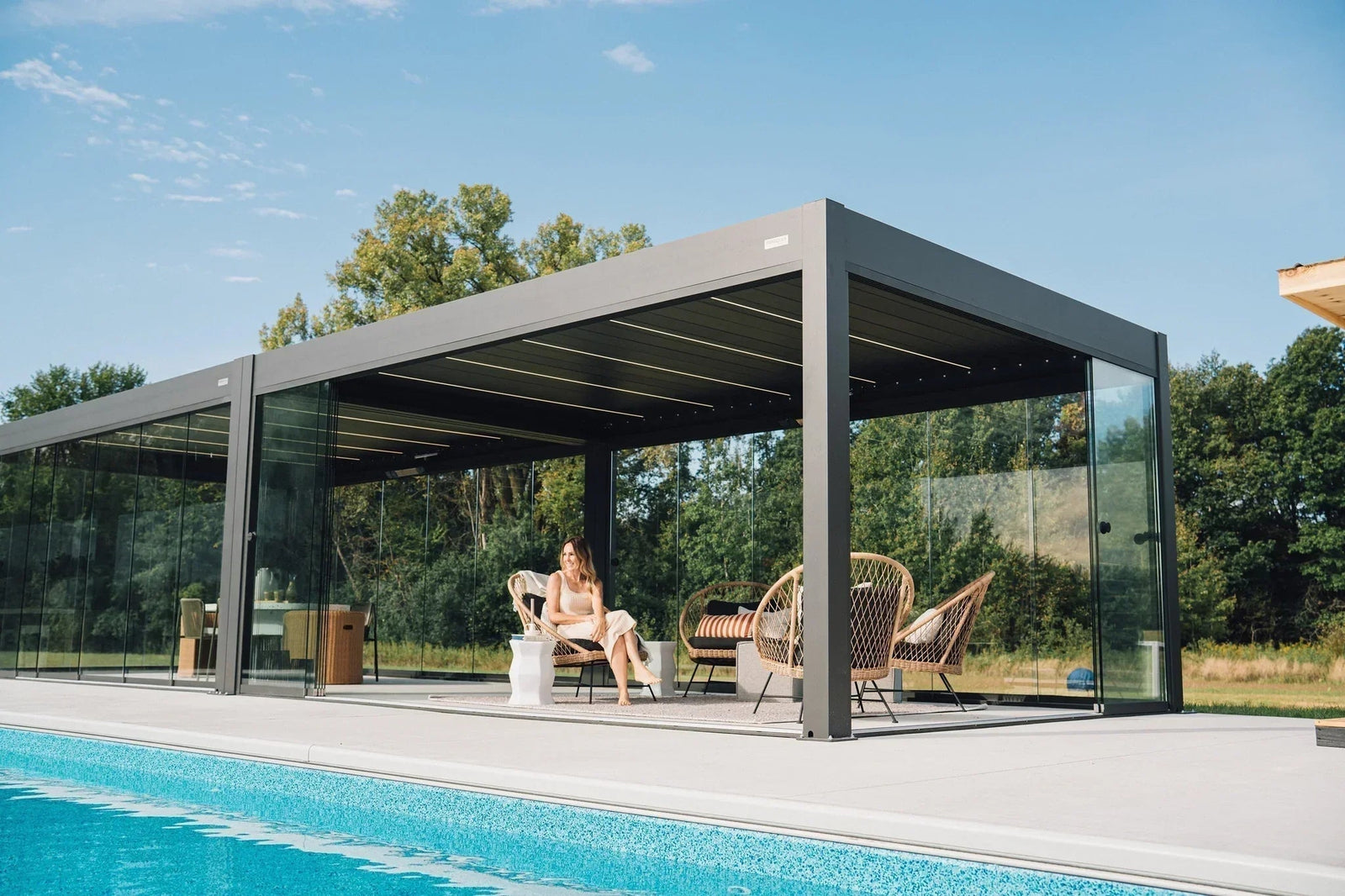How to Create a Pergola Base (Guide to Foundations and Footing)

In this article:
- Why a pergola base matters
- Navigating permits and permissions
- Installing on patios or decks
- Pre-planning for a new foundation
- Picking a foundation type
- Images of foundation installs
- Frequently asked questions
Why foundation and footing are important for a pergola
You've invested in a beautiful pergola. The right foundation helps it last for decades. Think of the foundation as the roots of your new outdoor living room; without a solid base, the entire structure is at risk.
A proper foundation will:
- Prevent sagging, leaning, and wobbling, protecting the integrity of every joint and screw.
- Keep features like louvered roof panels and retractable screens working smoothly without binding or jamming
- Drain water more effectively through integrated gutters, keeping rain from pooling or damaging the structure
- Look better, adding significant value and polish to your home
Skipping or rushing the foundation is one of the biggest mistakes you can make. This guide will walk you through everything you need to get it right.
Navigating permits and building codes
While a foundation is always recommended for maximum stability, it may not be legally required. The answer depends your local building codes and existing surface.
You might need a permit for your pergola if:
- It is over a certain size
- It is attached directly to your house
- It has electrical or plumbing elements
These rules vary by state, city, and even neighborhood. Building codes and permit requirements can feel intimidating, but a quick phone call is usually all it takes to get clear answers.
You can:
- Search online for your city/county building permit office for accessory structure requirements.
- Call your local building department. Tell them a bit about the size and location you planned for your pergola, then ask if you need a permit or if there are foundation requirements.
- Don't forget your homeowners association (HOA) if you have one. Review your community's rules and get any required approvals.
Installing a pergola on an existing deck or patio
Already have a concrete patio or a wooden deck? You may be able to anchor your pergola directly to it, but only if the surface is strong enough. Here's what to assess:
Concrete base for pergola
A patio must be a solid, crack-free concrete slab at least 4 inches thick. Thin pavers set on sand are not a structural base and cannot be used.
Use a long level to check for significant dips or slopes that could affect the pergola's stability. Tap the surface with a hammer in several spots. A solid, high-pitched "ping" suggests a solid slab. A hollow, low-pitched "thud" could indicate separate pavers or a cracked base.

Wooden deck pergola base
A "floating" deck that sits on blocks is not suitable for supporting the weight and wind load of a large pergola. The desk itself must be supported by concrete footings that go below your frost line.
For a wooden deck, ensure the deck's footings are deep enough (below the frost line) to support the added weight of the pergola. If so, evaluate if will you be able to anchor the pergola posts directly to the deck's underlying support joists and beams. This is more stable than attaching only to deck boards. You may need to add extra blocking between joists for support.

Foundation planning: 3 steps before you dig
Evaluating the soil, utility needs, and layout requirements for your pergola space will inform your choice of foundation.
Mark and measure your layout
Accuracy comes first. Before any digging or concrete work, transfer the foundation plan to your yard exactly.
-
- Download the foundation plan for your pergola model. This is usually available on the product page, and will provide exact center-to-center post measurements. Having this in advance allows you to prepare the foundation before your pergola arrives, minimizing storage time.
- Mark the footprint using wood stakes connected by mason string. Each stake should go where the post center will be.
- Check that it's square. Measure diagonally from one corner to the other, then repeat the other way. The distances should be exactly the same.
A square layout ensures everything fits perfectly later. That helps posts align, louvers close smoothly, and drainage works as designed.

Assessing soil conditions
The type of subsoil under your pergola can determine which foundation is best. You can figure this out with a simple shovel test by digging a 1'x1' hole where the pergola post will go.
| Soil Type | What It Means | Foundation Recommendation |
| Hard, compacted clay, or rocky | Ground is strong enough to support concentrated weight. | Point foundation |
| Loose, sandy, or soft | Will easily shift or settle if a heavy structure is added. Need to distribute weight over a larger area. | Strip foundation, concrete slab |
| Large roots or boulders | Obstacles make digging precise holes difficult, ruling out a point foundation. | Strip foundation, concrete slab |

Planning for utilities
Will you want lighting, an outdoor fan, outlets for charging devices, or even a future outdoor kitchen? Now is the only easy time to plan for it.
-
- Design your layout. Mark where outlets, lights, and water lines will go. Confirm these align with furniture, appliances, or future accessories.
- Run conduits early. Lay electrical conduit (usually gray PVC) before pouring any concrete. For slabs, conduits will usually run through the gravel base so it emerges through the concrete. For pier or trench foundations, conduits usually run through the trenches.
- Put safety first. Consider hiring a licensed electrician or plumber to ensure everything meets code. It's a small investment that can prevent major rework later.

The 4 types of pergola foundations
| Foundation Type | Best for... | Difficulty | Cost | Key Benefit |
|---|---|---|---|---|
| Paving Slabs | Small or lightweight pergolas on stable, level ground. | Easy | $ | Quick and simple installation. |
| Concrete Footings (Point Foundation) | Situations with stable soil. | Medium | $$ | Uses less concrete and requires less digging. |
| Strip Foundation | Larger pergolas or when connecting points for added stability. | Hard | $$$ | Extremely strong and frost-proof. |
| Concrete Slab | Large pergolas of projects on unstable, soft, or loose soil. | Very Hard | $$$$ | Provides maximum possible stability. |
Paving slabs as a pergola base

Paving slabs are a simple foundation for smaller or lightweight pergolas. You'll have minimal digging. It is often more affordable than other foundation types. Paving slab foundations can often be installed without a contractor, but a level ground area must be prepared correctly.
When to choose a paving slab foundation:
-
- You’re building a small or medium lightweight pergola structure
- You want a DIY-friendly foundation with minimal excavation
- The installation area has firm, well-drained soil and mild weather conditions
What to know before you build:
-
- This is not a good base for heavy pergolas, like those with added glass walls or solid roofing, as pavers can crack or settle over time
- Excavation will only need to be around 12 inches deep in the soil
- Crushed stone and gravel are added and compacted
- Sand fills gaps between pavers to keep things from shifting
Strip foundations for pergolas

A strip foundation uses 12-18" wide strips of concrete poured using a rectangular frame. Your pergola posts are anchored to these strips. When built correctly, this is one of the most stable foundation types. It can be used with nearly any size or weight pergola model.
When to choose a strip foundation:
-
- You’re installing a heavier pergola
- You want to add sliding glass walls (strips are perfect to anchor the tracks)
- You live in freezing temperatures and need a frost-proof base
- Your installation spot has uneven or loose soil
What to know before you build:
-
- Trenches need to reach below the frost line, usually at least 30 inches deep
- Boards can be used to keep trench walls stable before pouring
- Your base layer needs to be properly compacted so concrete pours smooth
- When subsoil is weak, you can reinforce with a 4-inch concrete slab or compacted gravel with a polyethylene moisture barrier.
Concrete slab foundation for pergolas

A full concrete slab is the most stable and permanent base for a pergola. It distributes weight evenly and can work on unstable or moisture-prone soils. It is more labor-intensive and costly, but it's the most fool-proof option if you want to ensure your pergola stays stable.
When to choose a concrete slab foundation:
-
- Your location has loose, unstable, or swampy soil that can shift
- You want a permanent, all-weather foundation for larger structures or built-in outdoor kitchens
- You prefer a surface that doubles as a finished patio floor
What to know before you build:
-
- Because so much concrete is used, professional mixing or delivery is recommended.
- A 16–20" pit will be dug to allow enough thickness o support the full weight of the structure and resist ground movement.
- Gravel is used as a base layer to improve drainage and prevent the slab from shifting or cracking over time.
- A polyethylene (PE) sheet between gravel and concrete blocks ground moisture, protecting the slab and any steel reinforcement from corrosion.
- Concrete is poured in two layers, with steel reinforcement mats between them for strength.
Concrete footers for pergolas (point foundation)

A point (or pier) foundation uses individual concrete footings under each pergola post instead of a continuous base. It's used on stable, load-bearing soil. This design saves material and cost while still providing strong support.
When to choose a point foundation:
-
- Your site has firm, compacted soil that can support weight evenly.
- You’re installing a medium-sized pergola that doesn’t require full-surface support.
- You want a cost-efficient foundation that uses less concrete and allows easy drainage.
What to know before you build:
-
- If the soil is soft or loose, the footings can shift or sink unevenly.
- Measurements are critical for ensuring each footing aligns with the pergola's post layout, otherwise things get misaligned.
- Study formwork boards or wide PVC pipes can be used as molds for concrete.
- Footings must be dug below the local frost line.
- Since less concrete is needed, ready-mix bags can often be used.
Pergola foundation ideas & project photos

Pergola posts are seen secured to their foundation footings, while the ground has been excavated and filled with a compacted gravel base, ready for the final patio pavers or concrete slab.

This pergola post is securely fastened with anchor bolts to a concrete point foundation. The surrounding patio pavers are cut to fit perfectly around the footing, and the integrated weatherproof outlet shows the value of planning for utilities before you build.

No perfectly flat patio? No problem. This installation shows how a pergola can be securely mounted on a traditional cobblestone surface for a seamless look.


This pergola is installed on a gravel patio using point foundations, where each post is securely anchored to its own individual concrete footing hidden just below the surface.
FAQs about pergola foundations
How much does a point foundation cost?
Costs vary by location and materials, but you can expect to pay between $150 and $400 per footing. Material costs for concrete, formwork, and hardware usually make up about $50 to $100 per footing, with the remainder going to labor if installed professionally.
What size should a point foundation footing be?
Foundation size depends on soil strength and the weight of the structure. For maximum stability, we recommend a 33 × 33 × 33 inch footing. In areas with firm, well-drained soil, smaller bases such as 15 × 15 × 30 inches are often sufficient.
How far apart should point foundations be?
You’ll need one footing for each pergola post. The spacing is defined by your model’s foundation plan. For example, a 10×13 ft. pergola typically requires four foundations, while a 13×20 ft. model may need six. Always refer to the foundation guide specific to your pergola before marking out measurements.
How are pergola posts anchored?
Pergola posts must be securely fastened to the foundation for stability and safety. We recommend using ½-inch diameter concrete wedge anchors or expansion anchors at least 5 inches long. These are drilled into the cured concrete to form a strong, reliable connection between the post flange and the foundation.
Can I build a pergola on an existing patio or deck?
Yes, a pergola can be build on an existing surface that is stable and properly supported. For patios, posts anchor through the paving into concrete footings below. For decks, posts should attach directly to the framing to handle load safely.
Can I install a pergola foundation myself?
DIY installation is possible for paving slabs and small point foundations. Larger concrete or strip foundations often require excavation tools, formwork, and precise leveling. These are best handled by professionals.
Find a pergola kit for your space

Now that you know about laying a foundation, check out popular pergola kit models to find specific details on foundation requirements based on size, style, and design.
This article was last reviewed and updated October 7, 2025.


